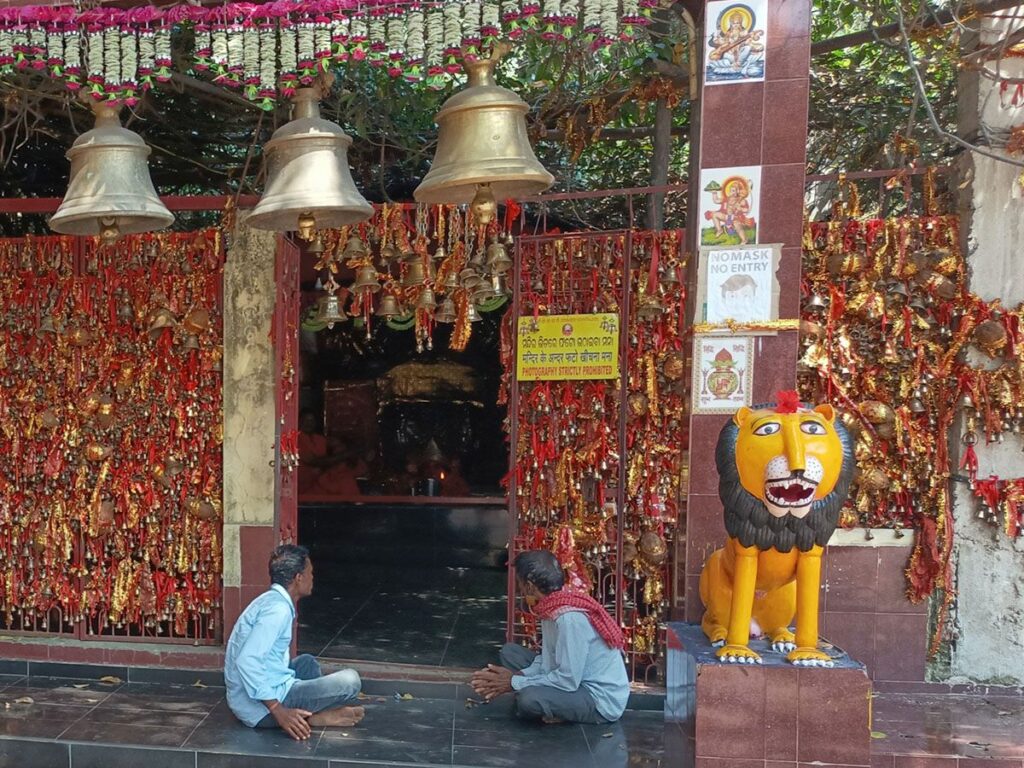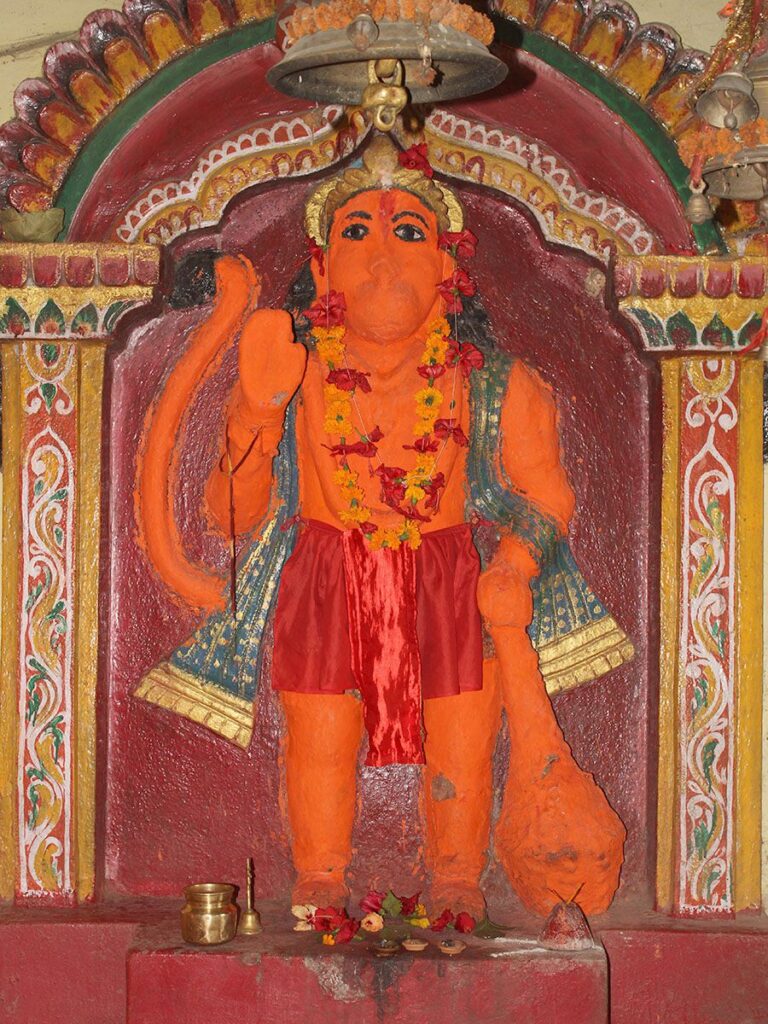Ghanteswari Temple Sambalpur
The Ghanteswari Temple is a Hindu temple dedicated to the goddess Ghanteswari, located in the town of Chipilima, in the Sambalpur district of Odisha, India. The temple is situated on the banks of the Mahanadi River, and is one of the most important pilgrimage sites in the state.

Contents
- 1 Ghanteswari Temple History:
- 2 Legend of Ghanteswari Temple:
- 3 Significance of Ghanteswari Temple:
- 4 Myths of Ghanteswari Temple:
- 5 Ghanteswari Temple Timing and rituals:
- 6 Places to visit near Ghanteswari Temple:
- 7 FAQ:
- 7.0.1 What is Ghanteswari Temple?
- 7.0.2 What is the history of Ghanteswari Temple?
- 7.0.3 What is the significance of Ghanteswari Temple?
- 7.0.4 What are the festivals celebrated at Ghanteswari Temple?
- 7.0.5 How to reach Ghanteswari Temple?
- 7.0.6 What are the timings of Ghanteswari Temple?
- 7.0.7 What are the dress code and other rules for visiting Ghanteswari Temple?
- 7.0.8 What are the nearby attractions to Ghanteswari Temple?
- 7.0.9 Why is Ghanteswari Temple famous?
- 8 How to reach Ghanteswari Temple:
- 9 Google Maps:
Ghanteswari Temple History:
Origins and Mythology:
- The exact date of construction remains unknown, but the temple’s origins are shrouded in legend. Many believe it dates back centuries, linked to the goddess Ghanteswari, the “Deity of Bells.”
- Folklore suggests the site held large bells that, through the wind, warned sailors of treacherous currents in the river, earning it the title “lighthouse without light.”
Practical Significance:
- Beyond the legend, the temple played a crucial role in aiding navigation. The numerous bells hanging around the temple complex served as an audible warning system for boats, especially during treacherous weather.
- This “warning system” prevented countless accidents, solidifying the temple’s importance for riverine travel.
Modern Times:
- Today, the temple continues to attract devotees seeking blessings from Goddess Ghanteswari.
- The tradition of offering bells as a form of gratitude for fulfilled wishes thrives, creating the unique spectacle of thousands of bells adorning the temple and surrounding areas.
- The construction of the Hirakud Dam nearby has somewhat lessened the navigational challenges, but the temple’s cultural and spiritual significance remains undiminished.
Read More>> Sri Puri Jagannath Temple: The Lord of the Universe

Legend of Ghanteswari Temple:
Version 1: The Grateful Daughter
Once upon a time, a wealthy merchant named Dhananjaya lived near the Mahanadi River. He had a beautiful and pious daughter named Leela who was devoted to Goddess Parvati. One day, a fierce storm struck, causing the river to overflow and threaten Leela’s life. In desperation, she prayed to Parvati, promising to offer 108 bells if she was saved. Miraculously, the floodwaters receded, sparing Leela. True to her word, she collected 108 bells and offered them at a small shrine on the riverbank. The shrine eventually blossomed into the Ghanteswari Temple, where devotees continue to offer bells as tokens of gratitude.
Version 2: The Lighthouse of Bells
In ancient times, sailors navigating the treacherous waters of the Mahanadi River feared strong winds and sudden storms. Legend has it that Maa Ghanteshwari, the goddess of bells, appeared before them, instructing them to hang bells along the riverbank. The rhythmic clanging of these bells would serve as a warning against approaching storms, guiding the sailors to safety. Over time, a temple dedicated to the goddess was built around these bells, earning it the title of the “lighthouse without light.”
Read More>> Konark Sun Temple 13th Century Gem

Significance of Ghanteswari Temple:
Religious Significance:
- Wish-fulfillment: Devotees tie bells to the temple structure as offerings to Goddess Ghanteswari, believing it signifies the fulfillment of their wishes. This practice has led to the temple being adorned with thousands of bells, creating a unique ambiance.
- Goddess Ghanteswari: The temple is dedicated to Goddess Ghanteshwari, also known as the Deity of Bells. She is associated with wishes, blessings, and protection.
Historical Significance:
- Navigation aid: In ancient times, the temple served as a navigational aid for sailors on the Mahanadi River. The sound of the numerous bells helped them avoid strong currents and whirlpools, earning it the nickname “lighthouse without light.”
- Cultural heritage: The temple represents a unique cultural tradition in Odisha, where offering bells as expressions of gratitude and hope is practiced.
Read More>> 64 Chausath Yogini Temple Hirapur Odisha

Myths of Ghanteswari Temple:
Many myths and legends are associated with the Ghanteswari Temple, adding to its mystique and allure. Here are a few of the most popular ones:
1. The Myth of the Warning Bells:
One legend tells the story of how the temple served as a “lighthouse without light” for sailors navigating the treacherous waters of the Mahanadi River. In ancient times, large bells hung from the temple, and their clanging in the wind warned sailors of the dangerous whirlpools and currents nearby. This myth highlights the temple’s historical significance as a landmark and navigational aid.
2. The Myth of the Wish-Granting Goddess:
Another popular myth revolves around the goddess Ghanteswari herself. It is believed that she is particularly benevolent and grants the wishes of her devotees who offer her bells. This belief has led to the temple becoming a popular pilgrimage site for people seeking blessings for good health, prosperity, and happiness.
3. The Myth of the Hidden Treasure:
Some legends whisper about a hidden treasure buried beneath the temple grounds. This treasure is said to be guarded by the goddess herself, and only those who are truly worthy will be able to find it. This myth adds to the temple’s aura of mystery and intrigue.
4. The Myth of the Talking Bells:
A lesser-known myth claims that the bells of the temple sometimes speak to their devotees. These messages are said to be cryptic and often contain guidance or warnings. However, only those with pure hearts and intentions can understand the true meaning of the bells’ whispers.
Read More>> Tara Tarini Temple Adi Shakti Odisha

Ghanteswari Temple Timing and rituals:
Timings:
General darshan: The temple is typically open from 6:00 AM to 8:00 PM. However, it’s advisable to confirm the exact timings before your visit, especially during festivals or special occasions.
- Aarti timings:
- Mangala Aarti: 6:00 AM
- Mahabhog Aarti: 12:00 PM
- Sandhya Aarti: 7:00 PM
Rituals:
- Darshan: Devotees first take a holy dip in the Maa Mahanadi River, which flows near the temple. Then, they offer prayers and perform darshan of the deity, Goddess Ghanteshwari.
- Puja: Different pujas are performed throughout the day, including Abhishek (holy bath), Shringar (decoration), and आरती (offering of light).
- Special pujas: Specific pujas are performed on Tuesdays and Saturdays, which are considered auspicious days to visit the temple.
Read More>> Vajreshwari Temple Maharashtra
Places to visit near Ghanteswari Temple:
- Sambalpur City: Explore the local culture, markets, and historical sites in Sambalpur, such as Sambalpur Fort and Samaleswari Temple.
- Hirakud Dam: One of the longest dams in the world, it is located on the Mahanadi River and offers scenic views. There’s a garden and a viewpoint that visitors often enjoy.
- Ushakothi Wildlife Sanctuary: Located around 43 km from Sambalpur, this sanctuary is known for its diverse flora and fauna.
- Debrigarh Wildlife Sanctuary: Situated around 40 km from Sambalpur, this sanctuary is home to various species of wildlife and offers a chance to explore nature.
- Chiplima Hydro Power Plant: This is about 37 km from Sambalpur and is known for its scenic beauty. The Hirakud Dam and the surrounding landscape can be viewed from here.
- Sambalpur University: If you’re interested in educational institutions, you might want to visit Sambalpur University and its campus.
- Cattle Island: It’s a small island located near Hirakud Dam with lush greenery and a peaceful environment.
- Gandhi Minar: Located in Sambalpur, it is a monument dedicated to Mahatma Gandhi and is a site of historical significance.
Read More>> 8th Century Mahabalipuram Shore Temple
FAQ:
What is Ghanteswari Temple?
Ghanteswari Temple is a Hindu temple dedicated to the goddess Ghanteswari, one of the many forms of the Hindu goddess Parvati. The temple is located in the town of Chiplima, in the Sambalpur district of Odisha, India.
What is the history of Ghanteswari Temple?
The exact date of construction of Ghanteswari Temple is unknown, but it is believed to have been built in the 16th century. The temple was renovated in the 18th century by the Chauhan rulers of Sambalpur.
What is the significance of Ghanteswari Temple?
Ghanteswari Temple is one of the most important religious sites in Odisha. The temple is known for its beautiful architecture and its intricate carvings. The temple is also home to a number of bells, which are said to have magical powers.
What are the festivals celebrated at Ghanteswari Temple?
The most important festival celebrated at Ghanteswari Temple is the Navratri festival. During Navratri, the temple is decorated with lights and flowers, and thousands of devotees visit the temple to offer prayers to the goddess.
How to reach Ghanteswari Temple?
Ghanteswari Temple is located about 30 kilometers from Sambalpur city. The temple can be reached by road or by rail. The nearest railway station is Sambalpur Junction, which is about 35 kilometers from the temple.
What are the timings of Ghanteswari Temple?
The temple is open from 4:00 AM to 8:00 PM.
What are the dress code and other rules for visiting Ghanteswari Temple?
Visitors are required to dress modestly when visiting the temple. Photography is not allowed inside the temple.
What are the nearby attractions to Ghanteswari Temple?
The nearby attractions to Ghanteswari Temple include the Hirakud Dam, the Sambalpur University, and the Sambalpur Museum.
Why is Ghanteswari Temple famous?
1. Bells, Bells Everywhere: As the name suggests, “Ghanteswari” translates to “Goddess of Bells.” Thousands of bells adorn the temple and surrounding area, offered by devotees as thanks for fulfilled wishes. This unique visual and the accompanying soft chimes contribute to its charm.
2. Historical “Lighthouse without Light”: Before the Hirakud Dam’s construction, this confluence of three streams had treacherous currents. The temple’s bells, swayed by winds, served as an audible warning system for sailors, earning it the moniker “lighthouse without light.”
How to reach Ghanteswari Temple:
By Air: The nearest airport to Sambalpur is the Veer Surendra Sai Airport (formerly Jharsuguda Airport). After reaching the airport, you can hire a taxi or use public transportation to reach Sambalpur.
By Train: Sambalpur Junction is the main railway station in the region. You can check the train schedules and book tickets to Sambalpur Junction. From the railway station, you can hire a taxi or use local transportation to reach Ghanteswari Temple.
By Road: Sambalpur is well-connected by road. You can either take a bus or hire a taxi from nearby cities or towns to reach Sambalpur. Once you are in Sambalpur, Ghanteswari Temple is likely to be accessible by local transportation or a short taxi ride.
Local Transportation: Upon reaching Sambalpur, you can hire a local taxi or use auto-rickshaws to reach Ghanteswari Temple. It’s advisable to ask locals for specific directions as road conditions and landmarks may change.
